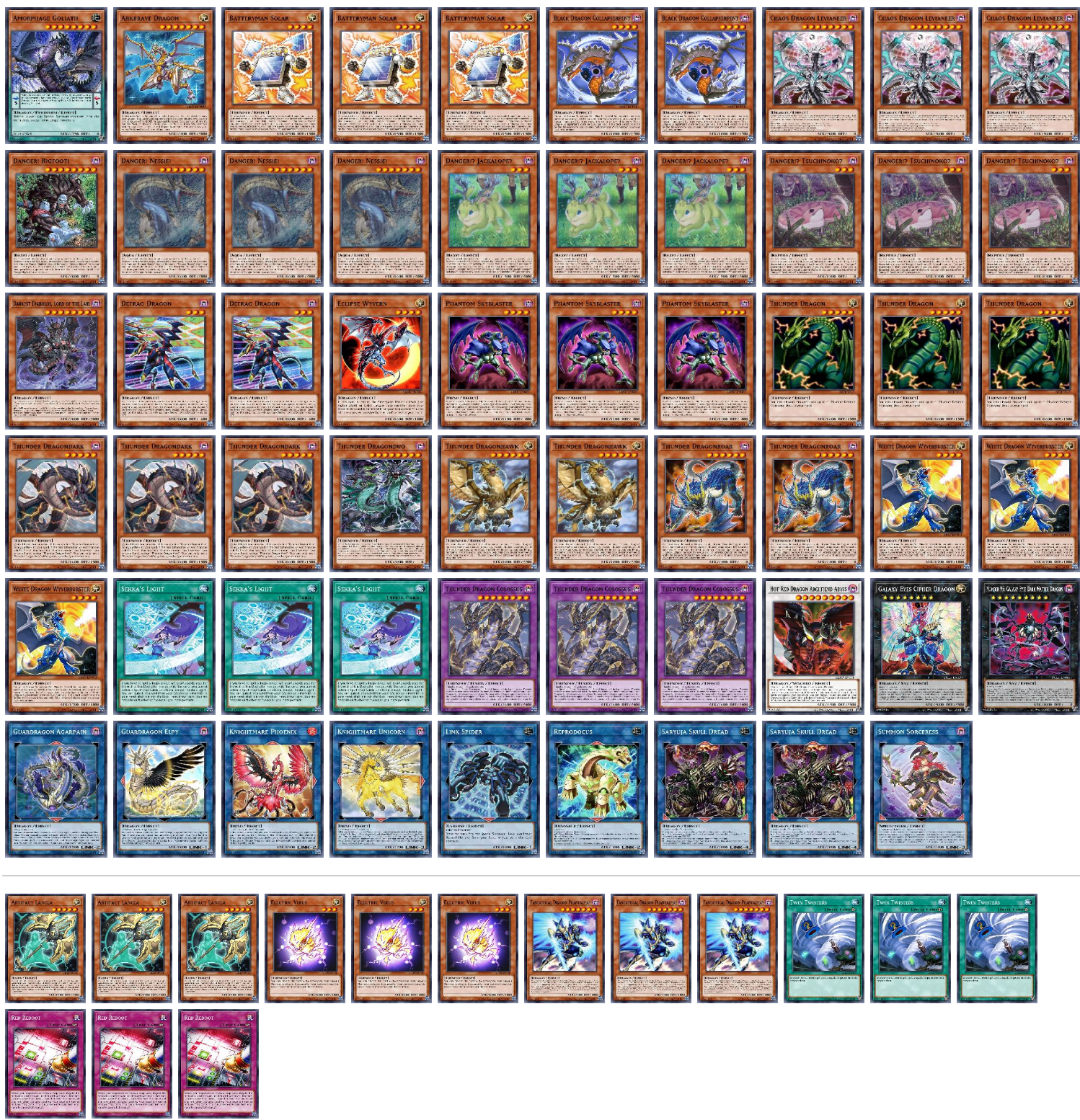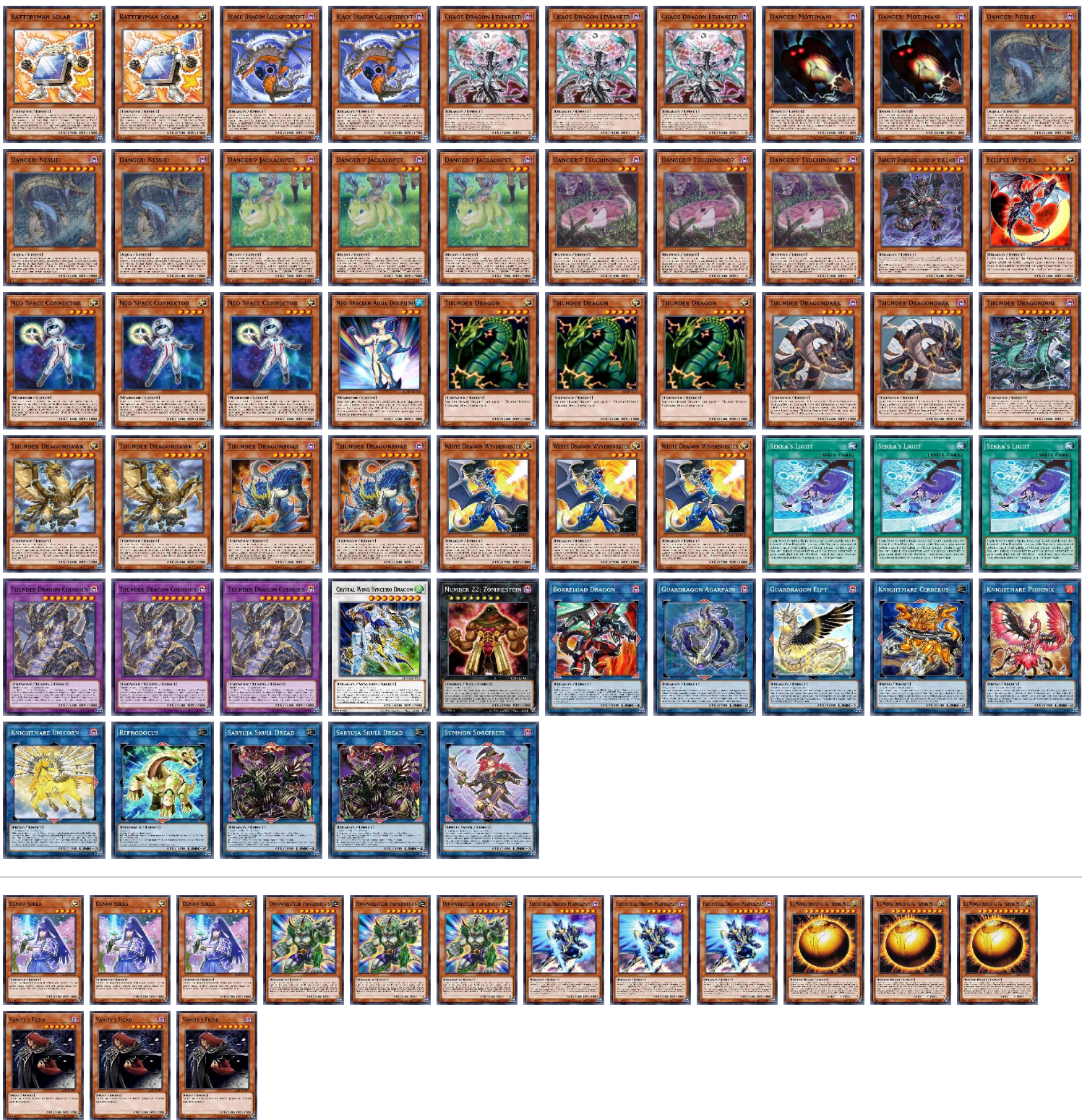Tier 1: Highly Competitive Meta Decks. 10% or more of tops, as ranked by Pojo. This will roughly correspond to Pojo’s Tier 1, with some overlap into Pojo’s Tier 2.
Tier 2: Semi-Competitive Meta Decks. Less than 10% of tops, as ranked by Pojo. Corresponds to the rest of Pojo’s Tier 2, Pojo’s Tier 3, and Rogue.
Tier 3: Semi-Competitive non-Meta/Rogue decks. 1-2 tops. Specifically includes decks that only top small events or get lower rankings at medium events. Can also include decks that can potentially top but have not yet in a given format.
Tier 4: Casually Competitive non-Meta decks. Decks that can compete at the locals level, but cannot top an event.
Archetype Explanation
Ahh, Thunder Dragon. Ever the bridesmaid, never the bride. For the fourth time now, Thunder Dragon has placed second in a YCS, managing to do it three times in one event at YCS Atlanta. Thunder Dragon's playstyle has changed significantly since it's arrival in the TCG in Soul Fusion. Modern Thunder Dragon is inevitably a Sekka's Light deck with a heavy Danger! engine, focused on extensive combos that end on a board full of beefy disruptions and floodgates. While Thunder Dragon Titan has fallen out of usage, the deck's other boss monster Thunder Dragon Colossus remains a prominent force in the TCG meta.
The deck's current strategy revolves around using the Thunder Dragon monsters in tandem with Danger! monsters to summon Saryuja Skull Dread and from there combo off into Guardragon monsters, eventually ending on a board with 1-2 Colossus, 1-2 further Extra Deck disruptions, and often an Amorphage Goliath and/or 1-3 cards ripped from the opponent's hand with Darkest Diabolos, Lord of the Lair and Chaos Dragon Levianeer. When Thunder Dragon opens well, its explosivity is almost unparalleled, and the deck has the resiliency to play through handtraps.
Tier Ranking
Thunder Dragon is solidly Tier 1 alongside Sky Striker and Salamangreat, taking 10 of the top 48 slots at YCS Atlanta. An entirely-Thunder Dragon team of TCG heavyweights Esala Wathutantrige, Aaron Furman, and Jesse Kotton narrowly missed out on taking the crown at Atlanta. The odds of Thunder Dragon falling in the meta before the next major set release or Forbidden/Limited list seems unlikely.
Decklists
The Thunder Dragon decklist is relatively standardized at this point. At the moment, the deck can be said to have been solved; the only differences in topping lists revolve around tech choices.
Jesse Kotton 2nd Place YCS Atlanta
 https://ygoprodeck.com/2nd-place-ycs-atlanta-thunder-dragon/
https://ygoprodeck.com/2nd-place-ycs-atlanta-thunder-dragon/Jesse Kotton and his teammates on Mare Mair Lair ran identical Thunder Dragon lists of the standard variety for this event. 44-card Thunder Dragon decks such as Mare Mare Lair's were in abundance at Atlanta's top cut. Defrag Dragon was an interesting tech idea, an extra extender that satisfies Guardragon summon restrictions. Kotton and his teammates elected to play Danger! Bigfoot over Danger! Mothman as an extra Level 8 monster.
The Mare Mare Lair list focuses on summoning a Colossus and then making Number 95: Galaxy-Eyes Dark Matter Dragon to dump Arkbrave Dragon and Amorphage Goliath for the next standby phase, with a Hot Red Dragon Archfiend Abyss protecting it all and a card or two gone from the opponent's hand thanks to Diabolos and Levianeer. The side deck is entirely for going second. According to commentators Billy Brake and Robbie Boyajian, Mare Mare Lair had a policy of siding in Red Reboot every time they went second out of fear of Summon Limit.
Gabe El-Allie Top 16 YCS Atlanta
 https://ygoprodeck.com/top-16-ycs-atlanta-thunder-dragon/
https://ygoprodeck.com/top-16-ycs-atlanta-thunder-dragon/Gabe El Allie's list is notable for being relatively distinct from the standard as set by Atlanta results. El-Allie eschewed both Phantom Skyblaster and the Amorphage Goliath-Arkbrave Dragon combo, choosing instead to run a slightly bulkier Danger! lineup and play only 40 cards. The main point of deviation is El-Allie's decision to run a Neos engine. Thunder Dragon cannot play Called by the Grave due to Danger! monsters and Sekka's Light, so Neo-Spacian Aqua Dolphin removes threatening handtraps. IT is notable, however, that El-Allie in his deck profile said that in the future he would run Skyblaster over the Neos engine.
El-Allie also chose to side Vanity's Fiend as a generically strong floodgate which can be summoned easily in the deck. The remainder of the side is fairly generic going-second cards. El-Allie chose to play Crystal Wing Synchro Dragon and Number 22: Zombiestein in his Extra Deck due to not running the Goliath-Arkbrave combo.
Tech Choices
Tech choices, at the moment, are the only real differentiation between Thunder Dragon decks in the current metagame. The most prominent is Chaos Emperor, the Dragon of Armageddon, whose accessibility is limited due to being a prize card. Electric Virus is becoming a more common going-second card alongside Dinowrestler Pankratops and The Winged Dragon of Ra - Sphere Mode. Virus can steal a Sky Striker link without triggering Raye or disrupt an opposing Thunder Dragon board. Other than Fantastical Dragon Phantazmay, Thunder Dragon decks are mostly declining to run handtraps.
The Amorphage Goliath-Arkbrave Dragon combo is arguably a near-staple at this point. Despite the continued presence of the Guardragons, Red-Eyes Darkness Metal Dragon has fallen out of favor due to being superfluous. Phantom Skyblaster is a popular card due to its swarming capabilities, but can clog hands alongside Batteryman Solar. Denko Sekka is an uncommon tech these days due to Thunder Dragon Fusion no longer being run. Thunder Dragon decks generally prefer to power through backrow with a slew of Danger! monsters, and Skyblaster and Solar are generally better normal summons.
Number 22: Zombiestein is falling somewhat out of favor compared to Hot Red Dragon Archfiend Abyss due to Thunder Dragon's current reliance on Guardragon combos. Hot RDA can also protect the Amorphage Goliath combo from Called by the Grave. Crystal Wing Synchro Dragon is another potential monster to summon off Guardragon Agarpain that can stop Electric Virus.
Matchups
Sky Striker
Thunder Dragon Colossus is still a one-card "No" to Sky Striker's main strategy. With cards like Number 22: Zombiestein, Fantastical Dragon Phantazmay, and Hot Red Dragon Archfiend Abyss, Thunder Dragon can disrupt Sky Striker Mecha - Widow Anchor and any other attempts to negate Colossus. The older Knightmare Gryphon-Eradicator Epidemic Virus combo is also a potential option to deal with Sky Striker's spells. Thunder Dragon is at a disadvantage in a grind game against Sky Striker, so removing or stopping Sky Striker Mecha Modules - Multirole is of the utmost importance.
Salamangreat
Thunder Dragon's Salamangreat matchup is somewhat lackluster. The deck really wants to win the dieroll to be in an advantageous position. Even if it does, Thunder Dragon Colossus is not always useful against Salamangreat due to the deck not relying heavily on searches. Salamangreat is also able to play a large number of handtraps to stunt Thunder Dragon's turn one plays. Salamangreat decks can also play Super Polymerization to cheaply and easily rip apart a Thunder Dragon board. Like Sky Strikers, Salamangreats will generally win a grind game against Thunder Dragon. Salamangreat is vulnerable in the early game before its engine has fully started rolling.
Thunder Dragon
The Thunder Dragon mirror match largely depends on the side deck; generally the winner of the dieroll will take game 1. Cards like The Winged Dragon of Ra - Sphere Mode, Droll & Lock Bird, and Artifact Lancea can all blow out the mirror when going second. Meanwhile, going first cards like Summon Limit can shut down the going second player. In general, however, the player who goes first in the mirror invariably has the advantage; side cards can mollify the advantage of going first but rarely eliminate it entirely. When going first, in the immortal words of Trif Gaming, simply stick to the gameplan.
Danger! Variants
Non-Thunder Dragon Danger! variants differ in that they generally desire to go second and attempt to OTK. Amorphage Goliath can often be enough to win this matchup alone, as most of the removal and power of Orcust/Lunalight/etc. comes from the Extra Deck. After game 1, Danger! decks will often choose to go first against Thunder Dragon so as to not let the deck set up its board. When going first against Thunder Dragon, Danger! decks tend to beeline for Outer Entity Azathot to essentially skip the Thunder Dragon player's turn. Dinowrestler Pankratops and Twin Twisters are easy counters to this strategy, though some Danger! decks are starting to play Decode Talker to thwart this.




